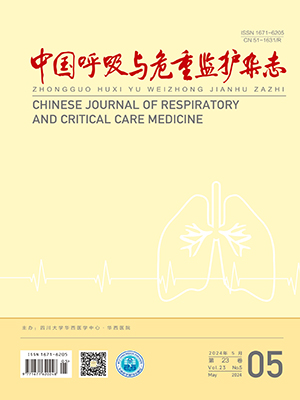| 1. |
Ferreira-Coimbra J, Sarda C, Rello J. Burden of community-acquired pneumonia and unmet clinical needs. Adv Ther, 2020, 37(4): 1302-1318.
|
| 2. |
Zhu YG, Tang XD, Lu YT, et al. Contemporary situation of community-acquired pneumonia in China: a systematic review. J Transl Int Med, 2018, 6(1): 26-31.
|
| 3. |
Chen L, Zhou F, Li H, et al. Disease characteristics and management of hospitalised adolescents and adults with community-acquired pneumonia in China: a retrospective multicentre survey. BMJ Open, 2018, 8(2): e018709.
|
| 4. |
Cao B, Huang Y, She DY, et al. Diagnosis and treatment of community-acquired pneumonia in adults: 2016 clinical practice guidelines by the Chinese Thoracic Society, Chinese Medical Association. Clin Respir J, 2018, 12(4): 1320-1360.
|
| 5. |
孔庆华, 白久武, 王晓如, 等. 三种评分系统在老年社区获得性肺炎危险度分层及病情评估中的应用. 中国呼吸与危重监护杂志, 2018, 17(2): 138-143.
|
| 6. |
Liu JL, Xu F, Zhou H, et al. Expanded CURB-65: a new score system predicts severity of community-acquired pneumonia with superior efficiency. Sci Rep, 2016, 6: 22911.
|
| 7. |
Khan F, Owens MB, Restrepo M, et al. Tools for outcome prediction in patients with community acquired pneumonia. Expert Rev Clin Pharmacol, 2017, 10(2): 201-211.
|
| 8. |
Ilg A, Moskowitz A, Konanki V, et al. Performance of the CURB-65 score in predicting critical care interventions in patients admitted with community-acquired pneumonia. Ann Emerg Med, 2019, 74(1): 60-68.
|
| 9. |
Mandell LA, Wunderink RG, Anzueto A, et al. Infectious Diseases Society of America/American Thoracic Society Consensus Guidelines on the management of community-acquired pneumonia in adults. Clini Infect Dis, 2007, 44(Suppl 2): S27-S72.
|
| 10. |
Ge YL, Liu CH, Xu J, et al. Serum high-sensitivity C reactive protein improves sensitivity of curb-65 in predicting icu admission and mortality in community-acquired pneumonia patients. Clin Lab, 2018, 64(10): 1749-1754.
|
| 11. |
Ito A, Ishida T, Tokumasu H, et al. Prognostic factors in hospitalized community-acquired pneumonia: a retrospective study of a prospective observational cohort. BMC Pulm Med, 2017, 17(1): 78.
|
| 12. |
Cerda-Mancillas MC, Santiago-Germán D, Andrade-Bravo B, et al. D-dimer as a biomarker of severity and adverse outcomes in patients with community acquired pneumonia. Arch Med Res, 2020, 51(5): 429-435.
|
| 13. |
Cirstea M, Walley KR, Russell JA, et al. Decreased high-density lipoprotein cholesterol level is an early prognostic marker for organ dysfunction and death in patients with suspected sepsis. J Crit Care, 2017, 38: 289-294.
|
| 14. |
Tao RJ, Luo XL, Xu W, et al. Viral infection in community acquired pneumonia patients with fever: a prospective observational study. J Thorac Dis, 2018, 10(7): 4387-4395.
|
| 15. |
Su Y, Ju MJ, Ma JF, et al. Lactate dehydrogenase as a prognostic marker of renal transplant recipients with severe community-acquired pneumonia: a 10-year retrospective study. Ann Transl Med, 2019, 7(22): 660.
|
| 16. |
周忠霞, 王霆, 王辉. 乳酸脱氢酶在成人社区获得性肺炎严重程度诊断中的价值. 临床肺科杂志, 2017, 22(6): 1026-1029.
|
| 17. |
Filippas-Ntekouan S, Liberopoulos E, Elisaf M. Lipid testing in infectious diseases: possible role in diagnosis and prognosis. Infection, 2017, 45(5): 575-588.
|
| 18. |
Tanaka S, Couret D, Tran-Dinh A, et al. High-density lipoproteins during sepsis: from bench to bedside. Crit Care, 2020, 24(1): 134.
|
| 19. |
Saballs M, Parra S, Sahun P, et al. HDL-c levels predict the presence of pleural effusion and the clinical outcome of community-acquired pneumonia. SpringerPlus, 2016, 5(1): 1491.
|
| 20. |
Chien YF, Chen CY, Hsu CL, et al. Decreased serum level of lipoprotein cholesterol is apoor prognostic factor for patients with severe community-acquired pneumonia that required intensive care unit admission. J Crit Care, 2015, 30(3): 506-510.
|
| 21. |
Chalmers JD, Singanayagam A, Akram AR, et al. Severity assessment tools for predicting mortality in hospitalised patients with community-acquired pneumonia. Systematic review and meta-analysis. Thorax, 2010, 65(10): 878-883.
|
| 22. |
Alavi-Moghaddam M, Bakhshi H, Rezaei B, et al. Pneumonia severity index compared to CURB-65 in predicting the outcome of community acquired pneumonia among patients referred to an Iranian emergency department: a prospective survey. Braz J Infect Dis, 2013, 17(2): 179-183.
|
| 23. |
Shimizu T. Inflammation-inducing factors of mycoplasma pneumoniae. Front Microbiol, 2016, 7: 414.
|
| 24. |
孔路科, 刘婷婷. 肺炎支原体感染与高密度脂蛋白代谢的研究进展. 中国基层医药, 2020, 27(7): 892-895.
|
| 25. |
Catapano AL, Pirillo A, Bonacina F, et al. HDL in innate and adaptive immunity. Cardiovasc Res, 2014, 103(3): 372-383.
|




